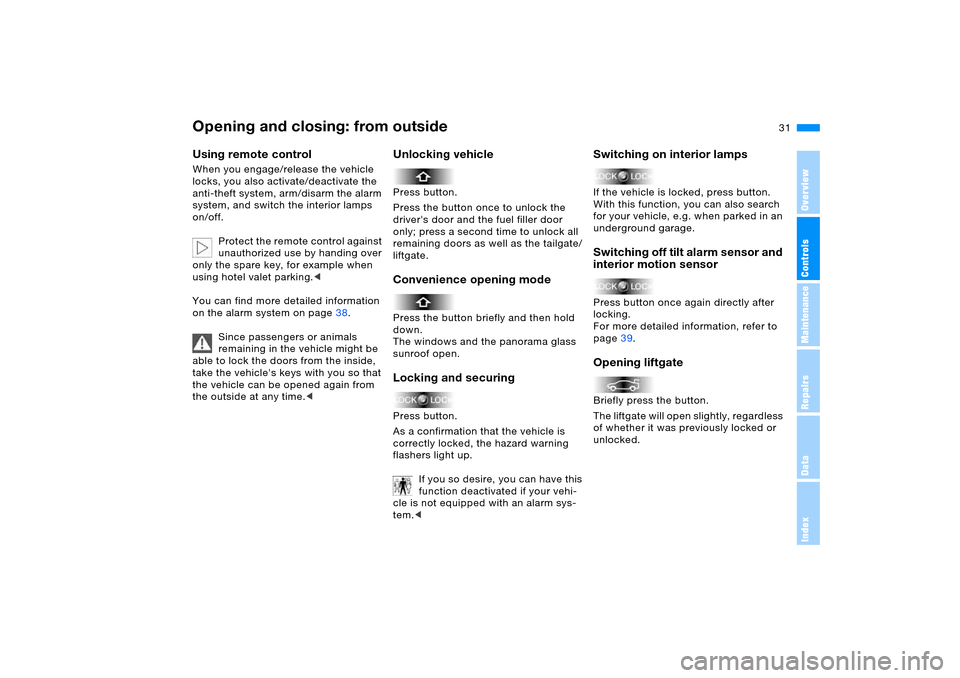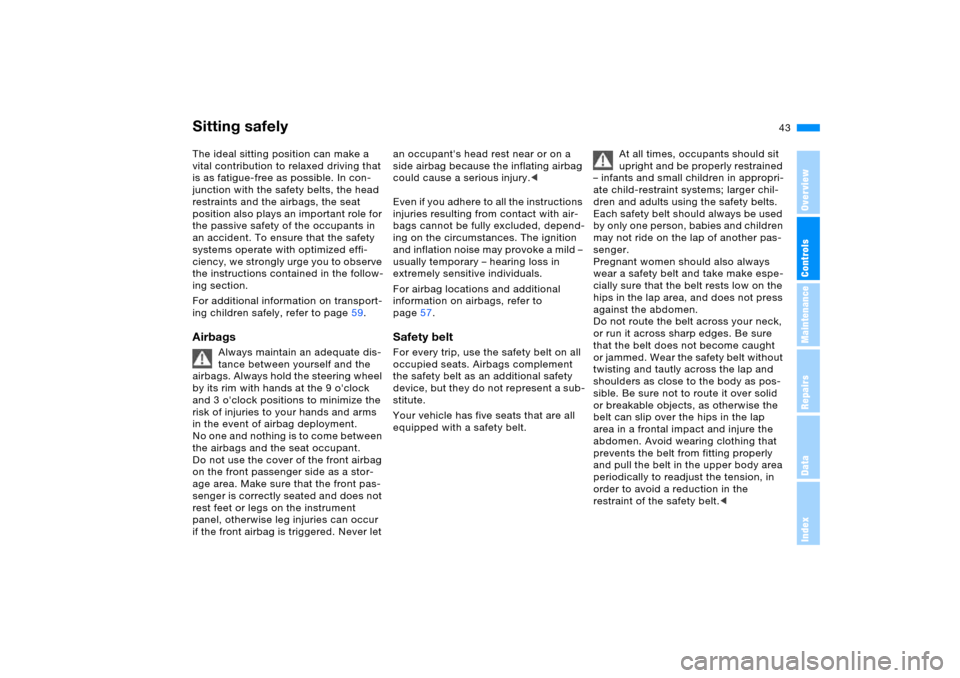2005 BMW X5 4.8IS maintenance
[x] Cancel search: maintenancePage 29 of 200

29n
OverviewControlsMaintenanceRepairsDataIndex
Overview
Controls and features
Operation, maintenance
Index Technical data
Controls
Owner service procedures
Page 31 of 200

OverviewControlsMaintenanceRepairsDataIndex
31n
Opening and closing: from outsideUsing remote control When you engage/release the vehicle
locks, you also activate/deactivate the
anti-theft system, arm/disarm the alarm
system, and switch the interior lamps
on/off.
Protect the remote control against
unauthorized use by handing over
only the spare key, for example when
using hotel valet parking.<
You can find more detailed information
on the alarm system on page38.
Since passengers or animals
remaining in the vehicle might be
able to lock the doors from the inside,
take the vehicle's keys with you so that
the vehicle can be opened again from
the outside at any time.<
Unlocking vehiclePress button.
Press the button once to unlock the
driver's door and the fuel filler door
only; press a second time to unlock all
remaining doors as well as the tailgate/
liftgate. Convenience opening modePress the button briefly and then hold
down.
The windows and the panorama glass
sunroof open. Locking and securing Press button.
As a confirmation that the vehicle is
correctly locked, the hazard warning
flashers light up.
If you so desire, you can have this
function deactivated if your vehi-
cle is not equipped with an alarm sys-
tem.<
Switching on interior lamps If the vehicle is locked, press button.
With this function, you can also search
for your vehicle, e.g. when parked in an
underground garage.Switching off tilt alarm sensor and
interior motion sensor
Press button once again directly after
locking.
For more detailed information, refer to
page39. Opening liftgate Briefly press the button.
The liftgate will open slightly, regardless
of whether it was previously locked or
unlocked.
Page 33 of 200

OverviewControlsMaintenanceRepairsDataIndex
33n
Opening and closing: from outsideUsing door lock One turn of the key in the driver's door
lock unlocks the driver's door only.
Turning the key a second time unlocks
all of the remaining doors, the liftgate/
tailgate and the fuel filler door.
As a confirmation that the vehicle is
correctly locked, the hazard warning
flashers light up.
If you so desire, you can deacti-
vate this function if your vehicle is
not equipped with an alarm system.< 530de244
Convenience operation You also have the option of operating
the windows and the panorama glass
sunroof from the door lock.
>To open: with the door closed, turn
the key to the Unlock position and
hold it.
>To close: with the door closed, turn
the key to the Lock position and hold
it.
Watch during the closing process
to be sure that no one is injured.
Releasing the key stops the operation.< Manual operation In the event of an electrical malfunction,
turn the key to the extreme left or right
to unlock/lock the door.
Page 35 of 200

OverviewControlsMaintenanceRepairsDataIndex
35n
LiftgateOpening from outside Press the button, refer to arrow:
The liftgate opens slightly.
The cargo area is illuminated whenever
the liftgate is opened, refer also to
page105.
With the liftgate open, the dis-
tance from the ground to the
upper edge is more than 6.6 ft/2 m.
Please consider this, e.g. when opening
the liftgate in a garage.<530de245
Opening from inside Press this button to open the liftgate
when the vehicle is stationary.
If pointed or sharp-edged objects
could strike the rear window while
driving, be sure to provide protection
around all edges. If you do not do this,
the heating conductors of the rear win-
dow could be damaged.<
For information on the cargo area cover
and on other details in the cargo area,
refer to Cargo area, beginning on
page126.530de415
Manual release In the event of an electrical malfunction,
you can release the liftgate manually:
1. Remove the plastic plug from inside
the cargo area and pull toward the
interior, refer to arrow. The liftgate
will be released
2. Reinstall the plug. 530de316
Page 37 of 200

OverviewControlsMaintenanceRepairsDataIndex
37n
Tailgate2. Using the same tool, press the latch
in the direction of the arrow; the tail-
gate is released
3. Reinstall the trim panel. 530de241
Luggage straps Use the retaining straps on the cargo
floor cover to secure smaller items of
luggage.
Movement is reduced when objects are
placed on the straps.
The lashing eyes located at the corners
of the cargo area provide you with a
convenient means of attaching luggage
nets
* or flexible straps for securing lug-
gage.
Refer also to Cargo loading on
page131.
394de302
Page 39 of 200

OverviewControlsMaintenanceRepairsDataIndex
39n
Alarm system Windows>The indicator lamp flashes for
10 seconds after the vehicle is
unlocked: an attempted entry has
been detected in the period since the
system was armed.
Following triggering of an alarm, the
indicator lamp will flash continuously. Tilt alarm sensor and interior
motion sensor Tilt alarm sensor:
The tilt of the vehicle is monitored. The
alarm system reacts, for example, if
someone attempts to steal the wheels
or tow the vehicle.
Interior motion sensor:
In order for the interior motion sensor
to function properly, the windows and
panorama glass sunroof must be com-
pletely closed.
Avoiding unintentional alarms The tilt alarm sensor and interior motion
s en sor m ay be swi tch e d off a t t h e sam e
time. This prevents unintentional
alarms, e.g. in the following situations:
>In stacking garages
>When transporting on car-carrying
trains
>If animals are to remain in the vehicle.
Switching off the tilt alarm sensor and
interior motion sensor:
Press the button on the remote control
twice consecutively.
The indicator lamp lights up briefly and
then flashes continuously. The tilt alarm
sensor and the interior motion sensor
are switched off up to the next unlock-
ing and locking actions.
Opening and closing windows As of ignition key position 1:
>Press the switch up to the resistance
point:
The window continues to move as
long as you continue to hold the
switch
>Briefly press the switch beyond the
resistance point:
The window moves downward auto-
matically. Briefly press the switch
again to stop the opening movement.
You can close the windows in the same
manner by pulling the switch.530us020
Page 41 of 200

OverviewControlsMaintenanceRepairsDataIndex
41n
Panorama glass sunroof
*
When leaving the vehicle, always
remove the remote control and
close the doors, as otherwise children
could operate the roof and injure them-
selves etc.<
The panorama glass sunroof is opera-
tional from ignition key position 1.
After the ignition has been switched off:
You can operate the panorama glass
sunroof for up to 1 minute as long as
neither of the doors has been opened.
Raising, opening, closingPress the switch or slide it in the
desired direction up to the resistance
point.
Release the switch to stop the motion.
The sliding visor is opened slightly
when the panorama glass sunroof is
raised.
The panorama glass sunroof can be
opened or closed independently with
the sliding visor open.530us242
Ventilation setting:
The panorama glass sunroof is raised
and the sliding visor is opened slightly:
Briefly press the switch twice consecu-
tively.Automatic opening and closing Briefly press the switch beyond the
resistance point and then release it.
Briefly pressing the switch again stops
the motion.
Opening and closing panorama glass
sunroof and sliding visor together:
Briefly press the switch beyond the
resistance point twice consecutively.
Briefly pressing the switch again stops
the motion.Comfort position Each time the panorama glass sunroof
is completely opened or closed, it stops
in the comfort position. If desired, con-
tinue the motion following this with the
switch.
In the comfort position the wind noises
in the interior are reduced.
Page 43 of 200

43n
OverviewControlsMaintenanceRepairsDataIndex
The ideal sitting position can make a
vital contribution to relaxed driving that
is as fatigue-free as possible. In con-
junction with the safety belts, the head
restraints and the airbags, the seat
position also plays an important role for
the passive safety of the occupants in
an accident. To ensure that the safety
systems operate with optimized effi-
ciency, we strongly urge you to observe
the instructions contained in the follow-
ing section.
For additional information on transport-
ing children safely, refer to page59.Airbags
Always maintain an adequate dis-
tance between yourself and the
airbags. Always hold the steering wheel
by its rim with hands at the 9 o'clock
and 3 o'clock positions to minimize the
risk of injuries to your hands and arms
in the event of airbag deployment.
No one and nothing is to come between
the airbags and the seat occupant.
Do not use the cover of the front airbag
on the front passenger side as a stor-
age area. Make sure that the front pas-
senger is correctly seated and does not
rest feet or legs on the instrument
panel, otherwise leg injuries can occur
if the front airbag is triggered. Never let
an occupant's head rest near or on a
side airbag because the inflating airbag
could cause a serious injury.<
Even if you adhere to all the instructions
injuries resulting from contact with air-
bags cannot be fully excluded, depend-
ing on the circumstances. The ignition
and inflation noise may provoke a mild –
usually temporary – hearing loss in
extremely sensitive individuals.
For airbag locations and additional
information on airbags, refer to
page57.Safety belt For every trip, use the safety belt on all
occupied seats. Airbags complement
the safety belt as an additional safety
device, but they do not represent a sub-
stitute.
Your vehicle has five seats that are all
equipped with a safety belt.At all times, occupants should sit
upright and be properly restrained
– infants and small children in appropri-
ate child-restraint systems; larger chil-
dren and adults using the safety belts.
Each safety belt should always be used
by only one person, babies and children
may not ride on the lap of another pas-
senger.
Pregnant women should also always
wear a safety belt and take make espe-
cially sure that the belt rests low on the
hips in the lap area, and does not press
against the abdomen.
Do not route the belt across your neck,
or run it across sharp edges. Be sure
that the belt does not become caught
or jammed. Wear the safety belt without
twisting and tautly across the lap and
shoulders as close to the body as pos-
sible. Be sure not to route it over solid
or breakable objects, as otherwise the
belt can slip over the hips in the lap
area in a frontal impact and injure the
abdomen. Avoid wearing clothing that
prevents the belt from fitting properly
and pull the belt in the upper body area
periodically to readjust the tension, in
order to avoid a reduction in the
restraint of the safety belt.<
Sitting safely